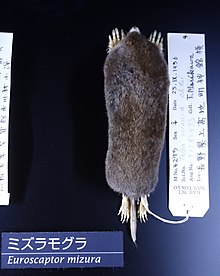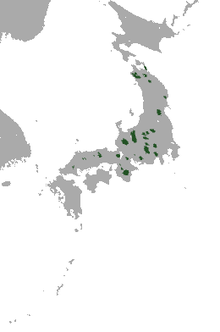Species of mammal
Japanese mountain mole
Conservation status
Least Concern (IUCN 3.1 )[1]
Scientific classification
Kingdom:
Animalia
Phylum:
Chordata
Class:
Mammalia
Order:
Eulipotyphla
Family:
Talpidae
Tribe:
Talpini
Genus:
Oreoscaptor Kawada, 2016
Species:
O. mizura
Binomial name
Oreoscaptor mizura
Japanese Mountain Mole range
Synonyms
Euroscaptor mizura
The Japanese mountain mole (Oreoscaptor mizura ) is a species of Old World mole in the family Talpidae . It is endemic to Japan . It is the only member of the monotypic genus Oreoscaptor habitats are temperate forests and temperate grassland .
Taxonomy [ ] Although the Japanese mountain mole was formerly classified in the genus Euroscaptor American Society of Mammalogists found that they did not truly belong to the genus because of earlier evolutionary divergence from other Euroscaptor species.[2] Oreoscaptor. [3] [4]
Morphology [ ] The taxonomic position of the species was reassessed in 2016 based on its external and skeletal morphologies. It was found that the muzzle of this species showed a unique groove on the ventral side, separating it from the rest of the moles in the family.[2] [3]
References [ ]
^ Laginha Pinto Correia, D. (2016). "Euroscaptor mizura " . IUCN Red List of Threatened Species 2016 : e.T8385A22320533. doi :10.2305/IUCN.UK.2016-1.RLTS.T8385A22320533.en ^ a b Shinohara, Akio; Kawada, Shin-ichiro; Son, Nguyen Truong; Koshimoto, Chihiro; Endo, Hideki; Can, Dang Ngoc; Suzuki, Hitoshi (2014-06-26). "Molecular phylogeny of East and Southeast Asian fossorial moles (Lipotyphla, Talpidae)" . Journal of Mammalogy . 95 (3): 455–466. doi :10.1644/13-mamm-a-135 ISSN 0022-2372 . ^ a b Kawada, Shin-ichiro (2016). "Morphological Review of the Japanese Mountain Mole (Eulipotyphla, Talpidae) with the Proposal of a New Genus" . Mammal Study . 41 (4): 191–205. doi :10.3106/041.041.0404 . ISSN 1343-4152 . ^ {Cite web|title=Explore the Database|url=https://www.mammaldiversity.org/explore.html#species-id=1004331%7Caccess-date=2021-10-09%7Cwebsite=www.mammaldiversity.org}}
Sources [ ]
Kingdom: Animalia
Phylum: Chordata
Class: Mammalia
Infraclass: Eutheria
Superorder: Laurasiatheria
Family: Erinaceidae subfamily: Erinaceinae
Atelerix Erinaceus
Amur hedgehog (E. amurensis ) Southern white-breasted hedgehog (E. concolor ) West European hedgehog (E. europaeus ) Northern white-breasted hedgehog (E. roumanicus ) Hemiechinus
Long-eared hedgehog (H. auritus ) Indian long-eared hedgehog (H. collaris ) Mesechinus Paraechinus
Family: Erinaceidae subfamily: Galericinae
Echinosorex Hylomys
Long-eared gymnure (H. megalotis ) Dwarf gymnure (H. parvus ) Short-tailed gymnure (H. suillus ) Neohylomys
Hainan gymnure (N. hainanensis ) Neotetracus
Shrew gymnure (N. sinensis ) Podogymnura
Dinagat gymnure (P. aureospinula ) Mindanao gymnure (P. truei )
Family: Soricidae subfamily: Crocidurinae
Crocidura (White-toothed
Family: Soricidae subfamily: Crocidurinae (continued)
Diplomesodon
Piebald shrew (D. pulchellum ) Feroculus Palawanosorex Paracrocidura (Large-headed Ruwenzorisorex
Ruwenzori shrew (R. suncoides ) Scutisorex Solisorex Suncus Sylvisorex (Forest shrews)
Family: Soricidae subfamily: Soricinae
Anourosorex (Asian mole shrews)
Blarinellini
Blarina (American short-tailed Cryptotis (Small-eared
Nectogalini
Chimarrogale (Asiatic water Chodsigoa Episoriculus Nectogale
Elegant water shrew (N. elegans ) Neomys
Mediterranean water shrew (N. anomalus ) Eurasian water shrew (N. fodiens ) Transcaucasian water shrew (N. teres ) Soriculus
Himalayan shrew (S. nigrescens )
Notiosoricini
Family: Soricidae subfamily: Soricinae (tribe: Soricini )
Sorex (Long-tailed
Subgenus
Long-tailed shrew (S. dispar ) Smoky shrew (S. fumeus ) American pygmy shrew (S. hoyi ) Large-toothed shrew (S. macrodon ) Carmen mountain shrew (S. milleri ) Dwarf shrew (S. nanus ) Mexican long-tailed shrew (S. oreopolus ) Orizaba long-tailed shrew (S. orizabae ) Ornate shrew (S. ornatus ) Inyo shrew (S. tenellus ) Verapaz shrew (S. veraepacis ) S. vagrans complexGlacier Bay water shrew (S. alaskanus ) Baird's shrew (S. bairdii ) Marsh shrew (S. bendirii ) Montane shrew (S. monticolus ) New Mexico shrew (S. neomexicanus ) Pacific shrew (S. pacificus ) American water shrew (S. palustris ) Fog shrew (S. sonomae ) Vagrant shrew (S. vagrans ) S. cinereus groupKamchatka shrew (S. camtschatica ) Cinereus shrew (S. cinereus ) Prairie shrew (S. haydeni ) Saint Lawrence Island shrew (S. jacksoni ) Paramushir shrew (S. leucogaster ) Southeastern shrew (S. longirostris ) Mount Lyell shrew (S. lyelli ) Portenko's shrew (S. portenkoi ) Preble's shrew (S. preblei ) Pribilof Island shrew (S. pribilofensis ) Olympic shrew (S. rohweri ) Barren ground shrew (S. ugyunak ) Subgenus incertae sedis
Family: Soricidae subfamily: Myosoricinae
Congosorex (Congo shrews) Myosorex (Mouse shrews) Surdisorex (African mole
Scalopinae (New World moles
Condylura
Star-nosed mole (C. cristata ) Parascalops
Hairy-tailed mole (P. breweri ) Scalopus
Eastern mole (S. aquaticus ) Scapanulus Scapanus (Western North
Talpinae (Old World moles
Euroscaptor Mogera
Echigo mole (M. etigo ) Insular mole (M. insularis ) Kano mole (M. kanoana ) Kobe mole (M. kobeae ) Small Japanese mole (M. imaizumii ) Large mole (M. robusta ) Sado mole (M. tokudae ) Japanese mole (M. wogura ) Senkaku mole (M. uchidai ) Parascaptor Scaptochirus
Short-faced mole (S. moschatus ) Talpa Scaptonyx
Long-tailed mole (S. fusicaudus ) Desmana
Russian desman (D. moschata ) Galemys
Pyrenean desman (G. pyrenaicus ) Dymecodon Urotrichus
Japanese shrew mole (U. talpoides ) Neurotrichus
American shrew mole (N. gibbsii )
Uropsilinae (Chinese shrew-like
Solenodon
Cuban solenodon (S. cubanus ) Hispaniolan solenodon (S. paradoxus )
Kawada, Shin-ichiro 2016. Morphological review of the Japanese mountain mole (Eulipotyphla, Talpidae) with the proposal of a new genus.


